In a world where everything is getting dependent on electricity, it is difficult for countries to produce that much electricity to meet their electricity consumption. In this situation, harnessing solar energy is a viable option, and it is already being used almost everywhere nowadays. And, its popularity is increasing every day. The number of companies offering Solar Panels has been growing lately, and it seems that the growth of the solar panel market will be going up-trend.
In this article, I am going to discuss how much electricity a solar panel produces but before that, it is good to understand how solar panels work.
Solar panels are made up of Photovoltaic cells, which are made from Silicon and a few other materials. When sunlight hits the PV cells(Photovoltaic Cells), it knocks electrons loose from their atoms which generate a flow of electricity.
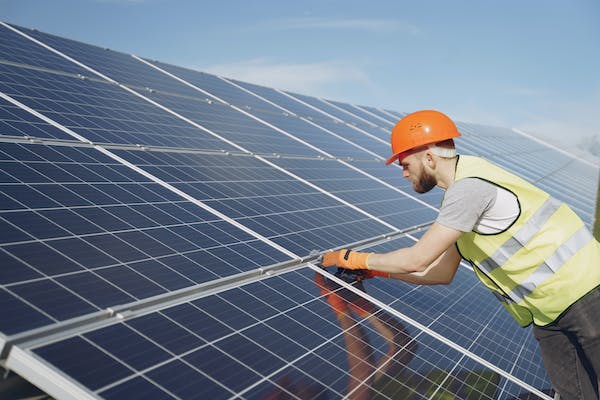
How Many Watts Does A Solar Panel Produce?
To know the answer to how much electricity a solar panel produce, you should know that it can be varied based on a variety of factors, such as the size and type of panel, the amount of sunlight it receives, etc. On average, a typical solar panel can produce from 250 to 400 Watts of electricity under ideal conditions.
To calculate the energy production of a solar panel, you can use the following formula:
Energy (kWh) = Power (Watts) x Time (hours) / 1000
For example, if a 250-watt solar panel receives full sunlight for 8 hours per day, it would produce:
Energy (kWh) = 250 x 8 / 1000 = 2 kWh Per Day
Please understand that this is an estimate only. The actual production of the solar panel may be affected by different factors such as the orientation of the panel, the angle, and the weather as well.
Photovoltaic Cells and Solar Energy Production
Solar Panels are made up of Photovoltaic cells which are made up in a way that they produce electricity when they are hit by the sunlight.
When sunlight touches the PV cells, it makes the electrons move around and generate electricity. This electricity is just like normal electricity which you can use for any purpose such as powering homes, offices, and all. Nowadays, most streetlights are powered by solar energy only. In the daytime, they are charged, and at the night they light up the streets.
Factors That Affect Solar Panel Energy Production
Although solar energy is a great natural resource to generate electricity without any pollution, there are a few factors that can affect it badly.
- Sunlight: Sunlight is the main source for producing energy, and if there is low sunlight, it will not produce more energy. The more sunlight the panel gets, the more electricity it can produce. So, in rainy and winter seasons solar energy production is low.
- Temperature: Although solar panels need more sunlight, you would be surprised to know that solar panels’ efficiency is decreased when the temperature rises. Thus, solar panels are often mounted in areas where they can receive plenty of sunlight but stay relatively cool.
- Angle and orientation: The angle and orientation of the solar panel can also affect its energy production. Panels that are angled toward the sun are supposed to produce more electricity than those that are not, and panels that face south or north will produce more electricity than those facing east or west.
- Efficiency: Solar panels’ efficiency also matters. A more efficient solar panel will produce more energy than the less efficient one.
- Shading: If your solar panel is in the shed of a tree or something which obstructs the sunlight to the panel, it would produce less energy. Thus shading can also affect energy production.
How to Measure Solar Panel Energy Production?
There are several ways to measure the energy production of a solar panel. The most common units of measurement are Watts (W) and Kilowatt Hours (kWh).
- Watts (W): It measures the rate at which energy is being produced at a specific moment in time. This unit of measurement is useful for determining the power output of a solar panel or system. For example, a solar panel with a rating of 250 watts can produce 250 watts of electricity under ideal conditions.
- Kilowatt-hours (kWh): It measures the total amount of energy produced by a solar panel over a period of time. This unit of measurement is useful for determining the overall energy production of a solar panel or system over a day, month, or year. For example, if a 250-watt solar panel produces 1-kilowatt hour of energy in one hour, it can produce 24 kWh of energy in one day under ideal conditions.
There are also tools such as monitoring systems and smart inverters that can track the energy production of a solar panel or system in real-time. These tools can provide detailed information on the energy production of each individual panel, as well as the system as a whole.
Difference Table Between Watts and KiloWatt-hours
| Features | Watt (W) | Kilowatt-hour (kWh) |
|---|---|---|
| Definition | A unit of power that measures the rate at which energy is generated or used. | A unit of energy that measures the amount of energy generated or used over a period of time. |
| Symbol | W | kWh |
| Formula | W = V x A (Vols x Ampear) | kWh = kW x h (Kilowatts x hours) |
| Example | A 40W light bulb uses 40 watts of power per hour. | If a 1 kW appliance is used for 1 hour, it will consume 1 kWh of energy. |
| Conversion | 1 kW = 1000 W | 1 kWh = 1000 Wh = 3.6 MJ (Megajoules) |
Types of Solar Panels Available in the Market
- Monocrystalline: These types of solar panels are made up of pure silicon. They are very highly efficient and last longer. Because of the great quality, these solar panels are pricey.
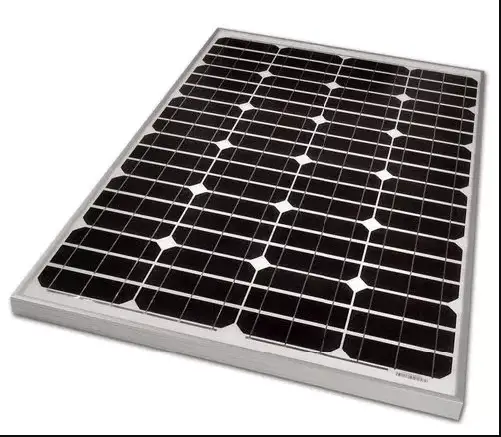
- Polycrystalline: These types of solar panels are made up of molten silicon crystals. These are medium or moderate efficient panels and have less lifespan. The price of Polycrystalline panels is lesser than Monocrystalline’s.
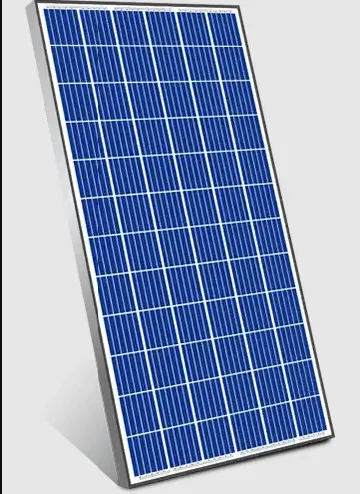
- Thin-Film: These types of solar panels are made up of mixing different materials including silicon. The efficiency is quite low, and also the lifespan is very less. But, it comes at a very cheap price.
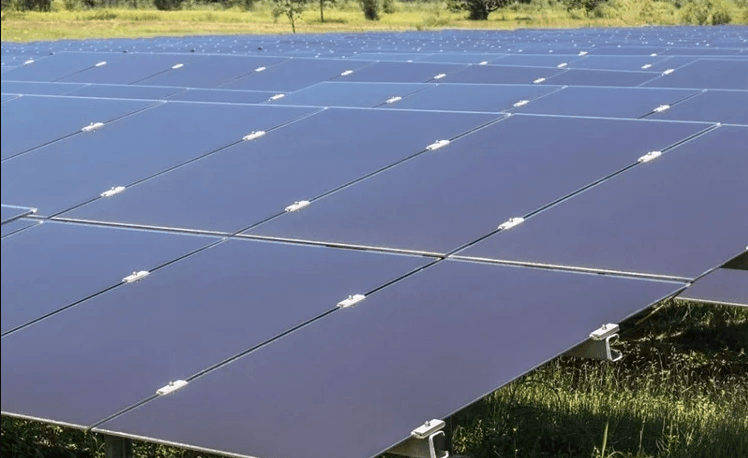
Difference Table Monocrystalline vs Polycrystalline vs Thin-Film Solar Panels
| Feature | Monocrystalline | Polycrystalline | Thin-film |
|---|---|---|---|
| Production | Made from single-crystal silicon | Made from multiple silicon fragments | Made from various materials deposited onto a substrate |
| Efficiency | Highest efficiency (15-22%) | Moderate efficiency (13-16%) | Lowest efficiency (7-13%) |
| Space requirements | It requires very less space to install | It requires more space than monocrystalline | It requires spacious place to install. |
| Cost | Most expensive due to the manufacturing process | Moderately priced | Least expensive |
| Temperature sensitivity | It is not much affected by high temperatures | More affected by high temperatures | It is very highly affected by high temperatures. |
| Durability | Most durable, can last up to 25 years or more | Less durable than monocrystalline, may last up to 20 years | Least durable, may last up to 10 years |
How to Take Care of Solar Panels?
When you have solar panels installed for your house or office or any building, you must have to take care of them regularly to make sure they produce optimum energy. Here are a few things you must do regularly:
- Cleaning the Dust: Since solar panels are in open areas they get covered with dust with time which obstructs sunlight to some extent that causes less power generation. Thus, you must make sure that they are being cleaned every then and now in order to keep them clean.
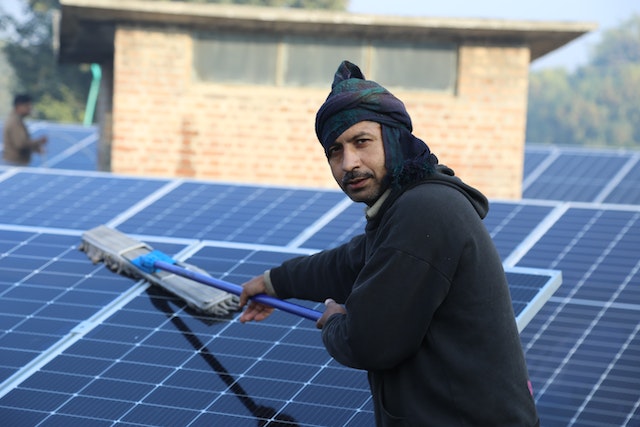
Photo: Pexels - Trimming of Tree branches: If there are trees that somehow block the sunlight, you must consider trimming the branches in a way that they don’t stop sunlight from touching the solar panel.
- Damage Check: Since the panels are installed outside in an open area, you may not be able to see if there are damages. Thus, keep a regular checking routing for damages.
Conclusion
As discussed, how much electricity can be produced by a Solar Panel depends on various factors but a typical solar panel produces from 250 to 400 Watts of electricity under normal conditions.
Hope this article helped you learn a bit more about solar panels. Share your thoughts in the comment section.







Add Comment